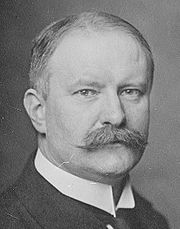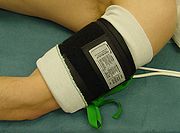
Intravenous regional anesthesia
Encyclopedia
Intravenous regional anesthesia (IVRA) or Bier block anesthesia is a common anesthetic
technique for surgical procedures
on the body's extremities where a local anesthetic
is injected intravenously
. The technique usually involves exsanguination, which forces blood out of the extremity, followed by the application of pneumatic tourniquets
to safely stop blood flow. The anesthetic agent is introduced into the limb and allowed to set in while tourniquets retain the agent within the desired area. After some time, the tourniquet is depressurized to restore circulation.
 The use of tourniquets and injected agents to induce localized anesthesia was first introduced by August Bier
The use of tourniquets and injected agents to induce localized anesthesia was first introduced by August Bier
in 1908. He used an Esmarch bandage
to exsanguinate the arm and injected procaine
between two tourniquets to quickly produce anesthetic and analgesic
effects in the site. Though it proved effective, IVRA remained relatively unpopular until C. McK. Holmes reintroduced it in 1963. Today, the technique is common due to its economy, rapid recovery, reliability, and simplicity.
 Protocols vary depending on local standard procedures and the extremity being operated on. A vast majority of practicioners begin by exsanguinating the limb as Bier did with an elastic bandage, squeezing blood proximally toward the heart. Pneumatic tourniquets are then applied to the limb and inflated to occlude all blood vessels. The local anesthetic, typically lidocaine
Protocols vary depending on local standard procedures and the extremity being operated on. A vast majority of practicioners begin by exsanguinating the limb as Bier did with an elastic bandage, squeezing blood proximally toward the heart. Pneumatic tourniquets are then applied to the limb and inflated to occlude all blood vessels. The local anesthetic, typically lidocaine
or prilocaine
, is slowly injected as distally as possible into the exsanguinated limb. The anesthetic sets in after approximately 20 minutes, at which point the tourniquets can be deflated and the surgery may begin. The wait time is important for avoiding toxic levels of anesthetics in the systemic bloodstream. Alternatively, the tourniquets may remain inflated to maintain a bloodless field.
Anesthesia
Anesthesia, or anaesthesia , traditionally meant the condition of having sensation blocked or temporarily taken away...
technique for surgical procedures
Surgery
Surgery is an ancient medical specialty that uses operative manual and instrumental techniques on a patient to investigate and/or treat a pathological condition such as disease or injury, or to help improve bodily function or appearance.An act of performing surgery may be called a surgical...
on the body's extremities where a local anesthetic
Local anesthetic
A local anesthetic is a drug that causes reversible local anesthesia, generally for the aim of having local analgesic effect, that is, inducing absence of pain sensation, although other local senses are often affected as well...
is injected intravenously
Intravenous therapy
Intravenous therapy or IV therapy is the infusion of liquid substances directly into a vein. The word intravenous simply means "within a vein". Therapies administered intravenously are often called specialty pharmaceuticals...
. The technique usually involves exsanguination, which forces blood out of the extremity, followed by the application of pneumatic tourniquets
Surgical tourniquet
Surgical tourniquets enable surgeons to work in a bloodless operative field by preventing blood flow to a limb. This allows surgical procedures to be performed with improved precision, safety and speed...
to safely stop blood flow. The anesthetic agent is introduced into the limb and allowed to set in while tourniquets retain the agent within the desired area. After some time, the tourniquet is depressurized to restore circulation.
History

August Bier
August Karl Gustav Bier was a German surgeon and a pioneer of spinal anaesthesia. After professorships in Greifswald and Bonn, Bier became a professor at the Charité in Berlin.-Spinal anesthesia:...
in 1908. He used an Esmarch bandage
Esmarch bandage
Esmarch bandage in its modern form is a narrow hard rubber tourniquet with a chain fastener that is used to control bleeding by applying it around a limb in such a way that blood is expelled from it. This prevents the flow of blood to or from the distal area, making it easier to operate...
to exsanguinate the arm and injected procaine
Procaine
Procaine is a local anesthetic drug of the amino ester group. It is used primarily to reduce the pain of intramuscular injection of penicillin, and it was also used in dentistry. Owing to the ubiquity of the trade name Novocain, in some regions procaine is referred to generically as novocaine...
between two tourniquets to quickly produce anesthetic and analgesic
Analgesic
An analgesic is any member of the group of drugs used to relieve pain . The word analgesic derives from Greek an- and algos ....
effects in the site. Though it proved effective, IVRA remained relatively unpopular until C. McK. Holmes reintroduced it in 1963. Today, the technique is common due to its economy, rapid recovery, reliability, and simplicity.
Methods

Lidocaine
Lidocaine , Xylocaine, or lignocaine is a common local anesthetic and antiarrhythmic drug. Lidocaine is used topically to relieve itching, burning and pain from skin inflammations, injected as a dental anesthetic or as a local anesthetic for minor surgery.- History :Lidocaine, the first amino...
or prilocaine
Prilocaine
Prilocaine is a local anesthetic of the amino amide type first prepared by Claes Tegner and Nils Lofgren. In its injectable form , it is often used in dentistry. It is also often combined with lidocaine as a preparation for dermal anesthesia , for treatment of conditions like paresthesia...
, is slowly injected as distally as possible into the exsanguinated limb. The anesthetic sets in after approximately 20 minutes, at which point the tourniquets can be deflated and the surgery may begin. The wait time is important for avoiding toxic levels of anesthetics in the systemic bloodstream. Alternatively, the tourniquets may remain inflated to maintain a bloodless field.
Safety
The safety and effectiveness of IVRA is well established in clinical literature. It is often preferred for shorter procedures on the distal limb, especially on the forearm, except when the patient was advised against tourniquet use. A systematic review of IVRA-related complications found 64 cases reported between 1964 and 2005, which compares favorably against other techniques. The type of anesthetic agent, improper equipment, and technical error are prominent factors in most instances of morbidity related to IVRA. Modern practice now includes various safeguards for improving safety.Equipment
Reports from anesthesiologists and surgeons cite proper selection, inspection, and maintenance of equipment as important safety measures. The safest tourniquet equipment should have IVRA-specific features such as independent limb occlusion pressure measurements for each channel, as well as dual-bladder tourniquet cuffs combined with dedicated safety lockouts that reduce human error. Additionally, IVRA protocols should include procedures for regular preventative maintenance of the equipment and performance testing, whether manual or automated, prior to surgery.Drug additives
Adjuvants improve the safety of IVRA by promoting anesthetic action and minimizing side effects. For example, benzodiazepine and fentanyl are often added to prevent seizures and to improve nerve blockage, respectively.Procedural safeguards
Improved protocols, including adherence to standardized practice, may also help ameliorate the chance and the effect of complications. For example, limb protection padding and a snug tourniquet application prevents tissue damage, while sufficient but not excessive tourniquet pressure ensures that anesthetics remain within the limb without risking injury. Should complications occur, constant physiological monitoring and ready access to resuscitative drugs and equipment facilitates a speedy response.See Also
- AnesthesiaAnesthesiaAnesthesia, or anaesthesia , traditionally meant the condition of having sensation blocked or temporarily taken away...
- August BierAugust BierAugust Karl Gustav Bier was a German surgeon and a pioneer of spinal anaesthesia. After professorships in Greifswald and Bonn, Bier became a professor at the Charité in Berlin.-Spinal anesthesia:...
- Regional AnesthesiaRegional anaesthesiaRegional anaesthesia is anaesthesia affecting only a large part of the body, such as a limb or the lower half of the body. Regional anaesthetic techniques can be divided into central and peripheral techniques. The central techniques include so called neuraxial blocks...
- Surgical TourniquetsSurgical tourniquetSurgical tourniquets enable surgeons to work in a bloodless operative field by preventing blood flow to a limb. This allows surgical procedures to be performed with improved precision, safety and speed...

